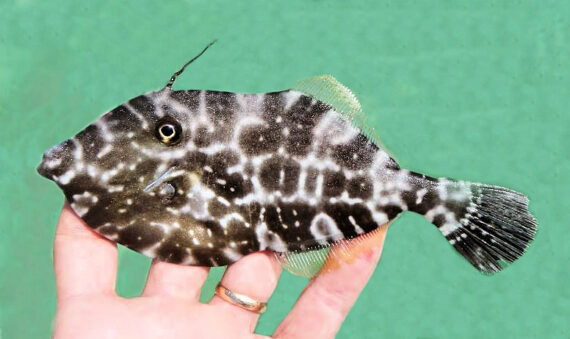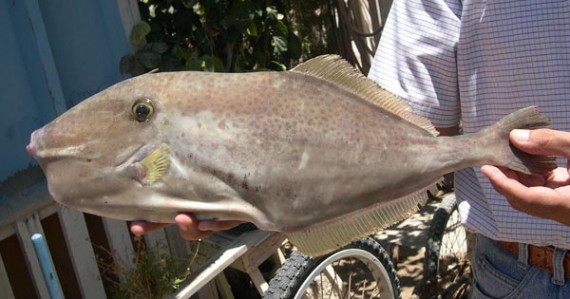Unicorn Filefish, Aluterus monoceros
 Unicorn Filefish, Aluterus monoceros, Juvenile. Fish caught from coastal waters off Belize, December 2020. Length: 15 cm (5.9 inches). Catch, photograph, and identification courtesy of Josh Leisen (joshadventures.com), Gaylord, Michigan.
Unicorn Filefish, Aluterus monoceros, Juvenile. Fish caught from coastal waters off Belize, December 2020. Length: 15 cm (5.9 inches). Catch, photograph, and identification courtesy of Josh Leisen (joshadventures.com), Gaylord, Michigan.
 Unicorn Filefish, Aluterus monoceros. Fish caught from coastal waters off Mazatlán, Sinaloa, April 2015. Length: 38 cm (15.5 inches). Catch, photograph and identification courtesy of George Brinkman, Guelph, Ontario, Canada.
Unicorn Filefish, Aluterus monoceros. Fish caught from coastal waters off Mazatlán, Sinaloa, April 2015. Length: 38 cm (15.5 inches). Catch, photograph and identification courtesy of George Brinkman, Guelph, Ontario, Canada.
 Unicorn Filefish, Aluterus monoceros. Fish provided by the commercial fishermen of the greater Los Cabos area, Baja California Sur, April 2009. Length: 50 cm (20 inches).
Unicorn Filefish, Aluterus monoceros. Fish provided by the commercial fishermen of the greater Los Cabos area, Baja California Sur, April 2009. Length: 50 cm (20 inches).
 Unicorn Filefish, Aluterus monoceros. Fish caught from coastal waters off Isle Coronado, Loreto, Baja California Sur, October 2019. Length: 52 cm (20 inches).
Unicorn Filefish, Aluterus monoceros. Fish caught from coastal waters off Isle Coronado, Loreto, Baja California Sur, October 2019. Length: 52 cm (20 inches).
 Unicorn Filefish, Aluterus monoceros. Fish caught from shore, Isla San Marcos, Baja California Sur, Mexico. Photograph courtesy of Mike Kanzler. Fish identification reconfirmed by Dr. Ross Robertson, Smithsonian Institute, Panama.
Unicorn Filefish, Aluterus monoceros. Fish caught from shore, Isla San Marcos, Baja California Sur, Mexico. Photograph courtesy of Mike Kanzler. Fish identification reconfirmed by Dr. Ross Robertson, Smithsonian Institute, Panama.
The Unicorn Filefish, Aluterus monoceros, is a member of the Filefish or Monoacanthidae Family, that is also known as the Unicorn Leatherjack Filefish and in Mexico as lija barbuda. Globally, there are four species in the genus Aluterus, and all four are found in Mexican waters, two in the Atlantic and two in both the Atlantic and the Pacific Oceans.
The Unicorn Filefish has a very compressed elongated oval body. They are gray to gray-brown in color with brown spots and blotches on their upper sides. Their anal and dorsal fins are pale yellowish brown and their tail membranes are dark brown. They have the ability to change color to match their surroundings. Upon death, their coloring transitions to a bland and uniform tan. Their head has a convex upper and concave lower profile and features a long pointed snout, a small centrally located upturned mouth, and small beady eyes located high on the back of the head. Their caudal fin base is longer than it is deep; the fins are relatively short with a straight or concave edge. Their dorsal fin has 2 spines, the first of which is long and slender and is located directly over the eye; it can be locked in position by the second smaller spine. When threatened, the Unicorn Filefish will dive quickly into a crevice in the reef, wedge themselves into the shelter by erecting and locking their first dorsal spine and another spine located on their belly. This behavior is also used when they rest on the reef at night. They lack pelvic fins. Their body is covered with small scales and small hairs creating a coarse sandpaper-like texture.
The adult Unicorn Filefish is a benthic species being found at depths up to 50 m (165 feet), and inhabit coral and rocky reefs; the juveniles are pelagic and found in and around floating debris at large distances from land. The Unicorn Filefish are secretive fish that hide in caves. They are omnivorous and feed on algae, anemones, gorgonians, sponges, and tunicates. In turn, they are preyed upon by larger fish including Dorado, Coryphaena hippurus, and Pacific Bluefin Tuna, Thunnus thynnus. They reach a maximum of 76 cm (2 feet 6 inches) in length. As of January 1, 2024, the International Game Fish Association world record stood 4.28 kg (9 lbs 7 oz) with the fish caught in coastal waters off Murrells Island, South Carolina, March 2023. They breed in groups consisting of 1 male and 2 to 5 females. The females lay demersal eggs in safe areas, such as depressions in the sand, and the eggs are then fertilized by the males. Both the males and the females will guard these fertilized eggs from predators. Upon hatching, the females will care for the young. The Unicorn Filefish is poorly studied with very limited information available about their lifestyle and behavioral patterns including specific details on age, growth, longevity, movement patterns, diet, habitat use, and reproduction.
The Unicorn Filefish has a wide circumglobal distribution in tropical and subtropical waters which includes the Eastern Atlantic (West Coast of Africa including the Mediterranean Sea), the Western Atlantic (Massachusetts to Argentina), and the Western Indian and Eastern Pacific Oceans (Baja California to Chile). The Unicorn Filefish is a resident of all Mexican waters of the Atlantic Ocean including the Gulf of Mexico and the Caribbean. In the Pacific they have a limited distribution being found from Magdalena Bay, Baja California Sur, southward along the southwest coast of Baja, in the southern two thirds of the Sea of Cortez, and along the coast of the mainland south to Guatemala. Photographic documentation of a fish caught in the Santa Rosalia, Baja California Sur, area of the Sea of Cortez is included below which establishes the northern range within the Sea of Cortez for this species. In Mexican waters they are one of the few species found in both the Atlantic and the Pacific Ocean.
The Unicorn Filefish is easily confused with the Scrawled Filefish, Aluterus scriptus (upper snout concave, rounded caudal fin).
From a conservation perspective the Unicorn Filefish is currently considered to be of Least Concern with stable, widely distributed populations. They are considered to be game fish in some parts of the world but in Mexico they are rare and of limited value, thus normally a “catch and release.” They are reported to contain ciguatoxin making them a poor food choice. They are collected and sold for the aquarium trade at a modest level. As they are a relatively shallow water slow-moving species, they are often the subject of underwater photographers.